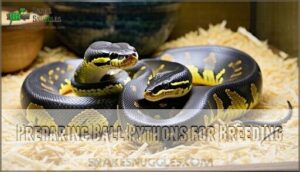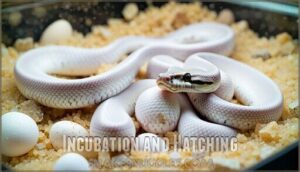This site is supported by our readers. We may earn a commission, at no cost to you, if you purchase through links.

Mimic their natural cycles by cooling the enclosure to 75–80°F at night for 2-3 months, while maintaining a day temperature of 85°F.
Gradually reintroduce higher temperatures and pair your snakes, watching for "locking", a sign of successful mating.
Afterward, females need a humid nesting area for laying eggs, and the eggs should be kept at 88–90°F with steady humidity during incubation, requiring patience and attention to detail.
Want to know how to spot courtship behavior or perfect humidity levels? Read on!
Table Of Contents
- Key Takeaways
- Preparing Ball Pythons for Breeding
- Breeding Season Preparation
- Temperature Regulation for Breeding
- Setting Up a Breeding Enclosure
- Mating and Egg Deposition
- Incubation and Hatching
- Hatchling Care and Early Development
- Ball Python Breeding Timeline
- Common Challenges and Solutions
- Best Practices for Successful Breeding
- Frequently Asked Questions (FAQs)
- How to get your ball pythons to breed?
- Is breeding ball pythons difficult?
- How long do you leave ball pythons together to breed?
- How do you encourage ball pythons to breed?
- How to tell if your ball python is ready to breed?
- How do you handle infertile ball python eggs?
- What are signs of successful ball python pairing?
- How often should I check on gravid females?
- What is the ideal diet during brumation?
- How to prevent stress in breeding ball pythons?
- Conclusion
Key Takeaways
- Confirm your ball pythons are healthy, mature, and meet minimum weight requirements (1,500 grams for females, 700 grams for males) before breeding.
- Mimic natural seasonal cycles by cooling enclosure temperatures to 75–80°F at night for 2–3 months, then return to higher temperatures to promote breeding behavior.
- Observe courtship behaviors like head-bobbing and tail-wrapping as signs of successful pairing, and provide a humid nesting area for egg-laying.
- Maintain steady temperature (88–90°F) and humidity (80–90%) during incubation for healthy development and successful hatching.
Preparing Ball Pythons for Breeding
To prepare ball pythons for breeding, you’ll need to confirm their sex, age, and overall health to verify they’re ready.
Confirm sex, age, and health to ensure your ball pythons are fully prepared for a successful breeding journey.
Focus on achieving ideal weight, scheduling vet check-ups, and maintaining proper care to set a strong foundation for success.
Verifying Sex and Age
Determining your ball python’s sex and age guarantees breeding success.
Try probing techniques—males probe deeper, around seven scales, versus three for females.
It’s accurate but requires practice.
Combine this with genetic testing or visual cues, like tail thickness, for a clearer picture.
Look for maturity signs, as females mature at 27 months, males by 18.
Proper sex determination prevents breeding issues.
Achieving Optimal Weight and Health
To prepare your ball pythons for breeding, focus on achieving healthy weight and consistent growth.
Make certain males weigh over 700 grams and females exceed 1,500 grams.
Here’s how:
- Feed responsibly: Avoid powerfeeding; offer appropriately sized prey to maintain steady growth.
- Monitor hydration: Provide fresh water daily, as dehydration impacts fat reserves and ball python health.
- Maintain exercise: Encourage movement to support muscle tone and overall breeding health.
Healthy adult selection makes a successful ball python breeding process certain.
Importance of Veterinary Check-Ups
A reptile veterinarian is key to ball python breeding success.
Prioritize parasite screening and preventative care to guarantee reproductive health and overall wellbeing.
Genetic counseling can help identify hidden risks impacting health.
Regular check-ups safeguard your snake’s breeding health by catching issues before they escalate, confirming their readiness.
Healthy, monitored snakes make for smoother breeding seasons and better outcomes.
Breeding Season Preparation
To prepare for the breeding season, you need to replicate the natural temperature and light cycles of a ball python’s habitat.
Carefully adjust feeding schedules, monitor their behavior, and introduce gradual changes to guarantee they’re ready to mate, which involves understanding and mimicking their natural habitat.
Understanding Natural Habitat Cycles
Ball pythons thrive by syncing with their natural environment, where seasonal shifts signal breeding readiness.
Seasonal shifts in nature guide ball pythons, signaling their readiness for breeding and fostering a harmonious connection to their environment.
In the wild, cooler months encourage natural brumation, slowing activity, aiding fat reserve buildup.
When temperatures rise alongside humidity changes, they interpret this as breeding season.
Understanding these cycles lets you replicate their rhythm.
Adjust their setup to mimic changes they’d experience in the wild.
Use gradual alterations in temperature, photoperiod, and humidity to create a habitat promoting healthy behavior.
It’s like recreating their tropical home, fostering comfort and breeding success.
Temperature Cycling and Brumation
Recreating seasonal changes through temperature cycling helps stimulate breeding behaviors.
Gradually reduce the enclosure’s daytime warmth to 75-78°F, cool the night side to 75°F, and maintain a steady warm-side gradient at 85°F.
This brumation method mimics nature, preparing snakes for breeding.
Keep humidity levels between 55-65% and monitor activity—reduced motion signals adjustment, ensuring optimum breeding conditions.
Feeding and Monitoring During Breeding Season
During the breeding season, keeping your ball python healthy starts with smart feeding and careful monitoring.
Snakes rely on their fat reserves to sustain energy, so feed adults every 14-21 days, adjusting as needed. Monitor weight consistently—obesity or sudden losses can disrupt breeding success.
Appetite changes? It’s normal, but track patterns closely.
Stay alert with these strategies:
- Feeding Frequency: Maintain regular intervals for energy and health.
- Weight Monitoring: Use a scale to check weekly progress.
- Hydration Strategies: Always provide fresh water; hydration supports digestion and reproduction.
Balance care, and your efforts will deliver great results.
Temperature Regulation for Breeding
Proper temperature regulation is essential for initiating successful breeding behavior in ball pythons, as it mimics seasonal changes in their natural environment.
By managing cooling periods and maintaining precise temperature gradients, you can create the ideal conditions for reproductive activity.
Cooling Process and Temperature Gradients
Creating the right temperature gradient is key to ball python breeding. Cooling benefits their natural cycles, triggering breeding behaviors. Gradually reduce enclosure temperatures over 4-6 weeks to mimic seasonal shifts. Aim for a warm side of 75°F–80°F and a cool side of 65°F–70°F.
Use cycling methods like night drops, lowering nighttime temperatures slightly more. Careful temperature monitoring guarantees stability. A reptile’s thermal gradient is vital for their health and breeding success.
Keep a digital thermometer handy to avoid sharp dips. Here’s an example cooling plan:
| Stage | Warm Side | Cool Side | Duration |
|---|---|---|---|
| 1 | 78°F | 75°F | 1 week |
| 2 | 75°F | 70°F | 1 week |
| 3 | 72°F | 68°F | 2 weeks |
| 4 | 70°F | 65°F | 2 weeks |
Cycling temperatures naturally promotes breeding readiness.
Brumation Guidelines and Humidity Control
Brumation requires precise conditions, so monitor humidity and temperature closely to avoid shedding issues or respiratory infections. Aim for 50-60% humidity, using cypress mulch for moisture retention.
Ventilation prevents illness while reducing activity signals brumation readiness. Snakes in this state may experience slowed metabolic functions.
Here’s a quick guide:
- Maintain 50-60% humidity levels.
- Use substrates like cypress mulch or sphagnum moss.
- Verify proper ventilation to prevent respiratory issues.
- Watch for reduced activity as brumation begins.
- Monitor temperature consistently for ideal conditions.
Setting Up a Breeding Enclosure
Setting up a breeding enclosure requires an environment that encourages natural behaviors while ensuring the snakes’ safety and health.
You’ll need to control temperature, humidity, and space carefully to create the ideal conditions for mating success.
Introducing Males and Females
Setting up your breeding enclosure starts with timing. Introduce the male ball python during the breeding season to a healthy, ready female.
Observe Compatibility Signs carefully—receptive females may relax while males display Mating Habits like tail alignment. Use a spacious enclosure, maintaining stress-free conditions.
A key element to success is a proper ball python habitat. Limit interaction to their Mating Duration, then guarantee Post-Mating Separation for recovery.
Careful health checks and deliberate Male Introduction maximize success in breeding ball pythons successfully.
Observing Courtship Behaviors and Locking Position
Courtship signals in ball pythons reveal their fascinating breeding habits. You’ll notice head-bobbing, a clear sign of interest, followed by tail-wrapping, confirming a successful lock.
Pay attention to these behaviors as part of your breeding observation.
- Mating duration: Locks can last from 4 hours to 2 days.
- Lock confirmation: Look for their tails intertwined.
- Male competition: Introducing another male can stimulate activity.
Understanding their mating habits boosts success during this critical stage of the breeding process.
Proper setup of a ball python habitat is essential for successful breeding.
Providing a Suitable Environment for Mating
If you’re planning a python breeding setup, the enclosure needs to feel safe and natural.
Use a spacious enclosure to give your ball pythons room to move and relax. Add hiding spots—ball pythons love cozy spaces for privacy.
Choose a substrate that maintains 50-60% humidity, like eco-friendly bedding. Guarantee constant water availability to support hydration.
For added security, include visual barriers to reduce stress, encouraging a successful breeding environment. A vital aspect involves managing temperature gradients within the enclosure.
Remember, when the breeding enclosure mimics their natural habitat, your ball pythons are more likely to feel comfortable and engage in breeding behaviors.
Mating and Egg Deposition
When it’s time for mating and egg deposition, proper preparation and observation are critical to guarantee success.
You’ll need to monitor courtship behavior, track ovulation, and provide an ideal space for the female to lay her eggs safely.
Creating a Humid Chamber for Egg Laying
Creating a humid chamber guarantees smooth egg-laying for ball pythons.
Use quality lay box materials like damp sphagnum moss or vermiculite for effective humidity maintenance.
Follow these steps:
- Choose substrate: Opt for moisture-retaining materials to protect eggs.
- Maintain ventilation: Prevent mold while keeping ideal humidity levels.
- Select chamber size: Provide comfort, ensuring proper temperature control for egg incubation.
This setup simplifies reptile egg care.
Monitoring Female Health and Egg Deposition
Tracking your female’s health during ball python breeding is vital.
Watch for gravid behavior, like swelling or significant weight gain, as these signal egg development.
Verify proper hydration levels and parasite monitoring to prevent complications.
A gravid female snake needs close observation during egg deposition to avoid retention issues.
After laying, focus on post-laying care, including diet and hydration, to hasten recovery.
Follicle size impacts clutch viability, so monitor closely for consistent growth.
Prioritize your snake’s health to maximize success while minimizing stress.
Incubation and Hatching
Incubation is a critical phase where you guarantee eggs are kept at precise temperatures and humidity levels to support healthy development.
By monitoring conditions closely and handling infertile eggs properly, you can give your hatchlings the best chance to thrive, which is a result of a successful incubation.
Creating a Controlled Environment for Incubation
After the eggs are laid, setting up the right incubator is key for python egg incubation.
Focus on:
- Incubator Selection: Pick one with reliable temperature control.
- Substrate Moisture: Use vermiculite or perlite, slightly damp, to prevent egg dehydration.
- Egg Candling: Check for embryo development and remove infertile eggs.
- Temperature Control: Maintain a steady 89°F (32°C).
This setup guarantees strong, healthy hatchlings.
A reliable setup also requires consistent humidity monitoring to maintain proper airflow.
Monitoring Temperature and Humidity Levels
Keeping eggs thriving demands steady temperature and humidity.
- Thermometer Placement: Position accurate gauges across the incubator. Readings must stay at 89-90°F.
- Humidity Sources: Use damp vermiculite or moss to hold 80-90% humidity.
- Temperature Control: Avoid drafts; place incubators in stable spots.
- Seasonal Adjustments: Regularly check microclimates, maintaining consistent levels.
Precision guarantees strong hatchlings!
Identifying Fertility and Handling Infertile Eggs
Candling helps assess egg viability by revealing veins in fertile eggs.
Infertile egg signs include smaller size, yellow color, or mold formation. Remove infertile eggs carefully to prevent incubation issues.
Troubleshoot incubation by monitoring fertility closely while managing temperature and humidity.
Fertility genetic factors and proper egg care play essential roles in egg development, ensuring healthier outcomes and successful breeding strategies for your ball pythons.
Hatchling Care and Early Development
Proper hatchling care begins with setting up a secure enclosure that maintains consistent temperature, humidity, and cleanliness.
You’ll also need to monitor their feeding habits and early growth to guarantee healthy development.
Providing a Suitable Environment for Hatchlings
Providing the right hatchling care starts with setting up a proper enclosure. Keep the space small and manageable to help hatchlings feel secure.
Use a soft, absorbent substrate like paper towels. Maintain humidity levels around 60% to aid shedding.
Make certain constant access to water and include small hides as enrichment options.
- Ideal hatchling enclosure size: cozy, not cramped
- Maintain 60% humidity requirements
- Use paper towels as a substrate
- Provide clean water for hydration
- Offer small hides for security
Feeding and Monitoring Hatchling Development
Monitoring hatchling care starts with consistent feeding. After their first shed, offer pinky mice that match their size, as feeding too large prey can cause issues.
Track their growth rate, hydration levels, and shedding cycles to guarantee healthy development. Use this guide for reference:
| Key Aspect | Ideal Practice | Common Issue |
|---|---|---|
| First Shed | Wait before feeding | Premature feeding |
| Pinky Mice | Match prey size | Oversized prey |
| Enclosure Setup | Maintain humidity levels | Dehydration risks |
The key to successful hatchling care is understanding the importance of prey size and hydration levels, and being aware of potential issues such as premature feeding and dehydration risks.
Understanding Genetic Outcomes and Morph Variability
Now that hatchlings are thriving, it’s time to explore ball python genetics to truly appreciate the beauty of morph inheritance.
Genetic outcomes reveal stunning possibilities, from subtle color shifts to striking patterns. Understanding recessive traits, co-dominance, and complex genes lets you create unique ball python morphs.
Always prioritize ethical morphs, avoiding pairings prone to genetic mutations or health concerns. Morph variability can surprise you—hidden visual traits often emerge unexpectedly.
With every clutch, you’re crafting nature’s artwork. Keep learning about genetic mutations and how they impact ball python morphs. It’s as much science as art, blending knowledge with mindful breeding practices.
Ball Python Breeding Timeline
Understanding the ball python breeding timeline is key to tracking each stage, from ovulation to hatching.
By documenting milestones and monitoring progress, you’ll guarantee a smooth and successful breeding process.
From Ovulation to Hatching
Spotting ovulation signs like a swollen abdomen means your ball python’s egg journey has begun.
Egg laying typically happens six weeks after mating. Once laid, transfer eggs to an incubation medium at 89°F for around 60 days.
- Check fertility through candling for vein patterns.
- Maintain the right humidity to avoid dehydration.
- Prepare enclosures for hatchlings before their first shed.
Documenting Development Stages and Milestones
During the incubation phase, keeping a close eye on development is key to successful ball python breeding. Maintain incubation temperatures consistent at 88°F to 90°F (31°C to 32°C) and document each milestone after hatching.
Start by logging ovulation signs and the gravidity period, then track egg candling results to monitor embryo health. Once hatchlings emerge, note their growth, shedding stages, and feeding progress.
Create a detailed table:
| Stage | Description |
|---|---|
| Hatch | Emergence from eggs |
| Initial Shed | First skin shedding |
| Feeding Phase | Successful feeding trials |
| Weight Tracking | Regular weigh-ins |
| Morph Expression | Notable features |
Careful documentation guarantees a smooth, informed breeding process.
Understanding The Importance of Patience and Monitoring
Breeding ball pythons demands patience and attentiveness. Success hinges on tracking details over time.
Keep an eye on their timeline awareness with these steps:
- Weigh regularly to monitor growth.
- Track feeding patterns for consistency.
- Observe behavior for signs of health.
- Log sheds by date.
- Check enclosure conditions like humidity daily.
It’s all about responsible breeding and regular health monitoring.
Common Challenges and Solutions
Breeding ball pythons comes with its fair share of challenges, from failed pairings to incubation mishaps.
Understanding these common issues and learning how to address them can substantially improve your success rate.
Overcoming Breeding and Incubation Challenges
Breeding challenges like infertile eggs and incubation setbacks can feel tricky, but careful attention to temperature and humidity solves most issues.
Even slight changes can lead to hatchling mortality or morph complications. Use egg candling to check for fertility. Keep your environment consistent—think of it as a recipe that needs precision.
| Challenge | Cause | Solution | Result |
|---|---|---|---|
| Infertile Eggs | Improper conditions | Monitor closely | Improved fertility |
| Egg Retention | Stress or low humidity | Increase humidity gently | Healthier females |
| Incubation Setbacks | Temperature fluctuations | Maintain consistency | Higher survival rates |
| Hatchling Mortality | Environment instability | Stabilize environment | Successful hatchlings |
Breeding requires careful management of the environment to avoid issues like incubation setbacks and ensure the health and viability of the hatchlings, leading to successful hatchlings and healthier females.
Addressing Health Issues in Ball Pythons
Taking care of your snake’s health secures smooth breeding.
Watch for common issues like respiratory infections, obesity risks, and shedding problems. Always prioritize reptile health to keep breeding stress-free.
- Parasite Prevention: Routine vet visits avoid parasite-related troubles.
- Scale Rot Checks: Keep enclosures clean and dry to prevent infections.
- Balanced Diets: Prevent health issues like obesity with proper portion sizes.
Troubleshooting Common Problems in Breeding and Incubation
You’ll encounter common problems, like infertile eggs, hatchling deformities, or incubation mold.
To troubleshoot effectively, check humidity levels to prevent stuck sheds or fragile embryos. If female rejection occurs, retry pairing after rest.
Regularly test incubators for malfunctions. Address health issues early for fertility success, and remember, incubation requires patience—monitor temperature and adjust often.
Understanding breeding temperature products can improve success. Small tweaks guarantee healthy, thriving offspring.
Best Practices for Successful Breeding
To breed ball pythons successfully, start by ensuring your snakes are healthy, mature, and meet the proper weight requirements.
Stay organized by keeping detailed records of their health, behavior, and breeding progress to avoid common mistakes, and ensure that you have a clear understanding of their health.
Selecting Healthy Adult Ball Pythons
While selecting adult ball pythons for breeding, focus on their health and readiness. Confirm they meet the minimum weight requirements, use age verification to confirm maturity, and prioritize overall genetic health.
Regular vet examinations help rule out issues, and evaluating proper body condition ensures breeding success.
Here’s your checklist:
- Meet weight thresholds (1500g+ for females).
- Verify age (2-3 years).
- Ensure clean genetic lines.
- Perform health checks.
Maintaining Accurate Records and Monitoring Development
Detailed record keeping is essential for successful breeding.
Track everything thoroughly to monitor development and health effectively:
- Record feeding habits and weights to assess progress and guarantee health.
- Log egg incubation details, including temperature and humidity.
- Document breeding timelines for each pair.
- Track genetic lineage to avoid inherited health issues, supporting responsible breeding decisions.
Continuously Educating Yourself and Staying Up-to-Date
To stay on top of breeding trends, explore breeding research and morph ethics, exploring health innovations and genetic updates.
Online community forums are goldmines for breeding insights and shared expertise.
| Focus Area | Why It’s Important | How to Stay Updated |
|---|---|---|
| Genetic Updates | Improve morph quality | Read research papers |
| Morph Ethics | Promote ethical breeding | Follow expert blogs |
| Health Innovations | Prioritize snake well-being | Attend seminars |
| Breeding Research | Enhance breeding knowledge | Join community discussions |
Expanding your breeding expertise means constant learning!
Frequently Asked Questions (FAQs)
How to get your ball pythons to breed?
It’s no accident that healthy, mature ball pythons thrive during breeding.
Verify females weigh 1,500 grams, males 700 grams, cycle temperatures to mimic seasons, and introduce pairs gradually, encouraging courtship behaviors like tail wrapping, which promotes healthy development.
Is breeding ball pythons difficult?
Breeding ball pythons isn’t too hard if you prepare properly.
Focus on healthy, mature snakes, guarantee ideal temperatures, and monitor behaviors.
Timing, weight, and health checks make all the difference for a smooth process.
How long do you leave ball pythons together to breed?
Think of pairing ball pythons like a slow dance; leave them together for 2-3 days or until you notice a “lock,” which may last 4-24 hours.
Separate them once the mating process is complete.
How do you encourage ball pythons to breed?
Lower the temperatures in their enclosures to mimic winter and introduce healthy males to females.
Adding a competing male, monitoring for courtship behaviors, and ensuring both snakes are healthy can help stimulate breeding successfully, which involves a process that requires careful management, including introducing a competing male.
How to tell if your ball python is ready to breed?
A healthy female ball python must weigh at least 1,500 grams, with males over 700 grams. Check maturity—females are ready around 3 years, males by 18 months. Probing confirms sex; watch diet closely.
How do you handle infertile ball python eggs?
Gently remove infertile eggs from the clutch to prevent mold spreading.
Don’t toss immediately—candle them to confirm no veins.
Discard securely, avoiding enclosure contamination.
Keep the viable eggs on moist substrate for proper incubation.
What are signs of successful ball python pairing?
When sparks fly in the snake world, look for tail-wrapping, head-bobbing, and extended locks lasting hours.
Post-pairing behavior, like a relaxed male and a swelling female, signals a successful ball python pairing.
How often should I check on gravid females?
Check on gravid females every few days to monitor for signs of stress, unusual behavior, or health issues.
Verify proper enclosure conditions, like humidity and temperature, and prepare a lay box as oviposition nears.
What is the ideal diet during brumation?
Don’t worry about complex diets—during brumation, prioritize hydration and offer small, easy-to-digest prey like appropriately sized rodents every few weeks.
Avoid overfeeding; the goal is maintenance, not growth, while keeping your python’s energy steady.
How to prevent stress in breeding ball pythons?
Reduce stress by providing secure hides, stable temperatures, and low traffic.
Don’t handle snakes during breeding unless necessary.
Use appropriate enclosure sizes, separate males after mating, and maintain consistent lighting to mimic their natural environment.
Conclusion
Did you know that female ball pythons can lay up to six eggs at once?
Breeding ball pythons successfully requires attention to detail at every step—from achieving the right weights and temperatures to monitoring humidity during incubation.
By mimicking their natural environment and carefully observing behaviors like courtship and locking, you’ll improve your chances of success.
Stay patient, track progress carefully, and focus on providing ideal conditions for both parents and hatchlings to thrive. Happy breeding!



















